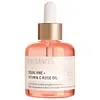What's inside
What's inside
 Key Ingredients
Key Ingredients

 Benefits
Benefits

 Concerns
Concerns

 Ingredients Side-by-side
Ingredients Side-by-side

Titanium Dioxide 3.5%
Cosmetic ColorantZinc Oxide 10%
Cosmetic Colorant1,2-Hexanediol
Skin ConditioningAcrylates/Dimethicone Copolymer
Skin ConditioningAllantoin
Skin ConditioningAlumina
AbrasiveBis-Vinyl Dimethicone/Dimethicone Copolymer
Emulsion StabilisingBisabolol
MaskingButyloctyl Salicylate
Skin ConditioningCamellia Oleifera Leaf Extract
AstringentCapparis Spinosa Fruit Extract
Skin ConditioningCaprylic/Capric Triglyceride
MaskingCaprylyl Glycol
EmollientCerium Oxide
Cetyl Dimethicone
EmollientDimethicone
EmollientDisteardimonium Hectorite
StabilisingGlycerin
HumectantHimanthalia Elongata Extract
Skin ProtectingIron Oxides
Mica
Cosmetic ColorantNiacinamide
SmoothingOlea Europaea Fruit Extract
BleachingOlea Europaea Leaf Extract
PerfumingOpuntia Ficus-Indica Stem Extract
Skin ConditioningPanthenol
Skin ConditioningPhenethyl Alcohol
MaskingPhenoxyethanol
PreservativePhenyl Trimethicone
Skin ConditioningPlankton Extract
Skin ConditioningPolyglyceryl-3 Sorbityl Linseedate
EmulsifyingPolyglyceryl-4 Oleate
EmulsifyingPolygonum Aviculare Extract
EmollientPolyhydroxystearic Acid
EmulsifyingPolymethyl Methacrylate
Potassium Sorbate
PreservativeSilica
AbrasiveSodium Benzoate
MaskingSodium Chloride
MaskingSqualane
EmollientStearic Acid
CleansingStyrene/Acrylates Copolymer
Tocopheryl Acetate
AntioxidantTriethyl Citrate
MaskingTropolone
Skin ConditioningUbiquinone
AntioxidantWater
Skin ConditioningZea Mays Starch
AbsorbentZingiber Officinale Root Extract
MaskingTitanium Dioxide 3.5%, Zinc Oxide 10%, 1,2-Hexanediol, Acrylates/Dimethicone Copolymer, Allantoin, Alumina, Bis-Vinyl Dimethicone/Dimethicone Copolymer, Bisabolol, Butyloctyl Salicylate, Camellia Oleifera Leaf Extract, Capparis Spinosa Fruit Extract, Caprylic/Capric Triglyceride, Caprylyl Glycol, Cerium Oxide, Cetyl Dimethicone, Dimethicone, Disteardimonium Hectorite, Glycerin, Himanthalia Elongata Extract, Iron Oxides, Mica, Niacinamide, Olea Europaea Fruit Extract, Olea Europaea Leaf Extract, Opuntia Ficus-Indica Stem Extract, Panthenol, Phenethyl Alcohol, Phenoxyethanol, Phenyl Trimethicone, Plankton Extract, Polyglyceryl-3 Sorbityl Linseedate, Polyglyceryl-4 Oleate, Polygonum Aviculare Extract, Polyhydroxystearic Acid, Polymethyl Methacrylate, Potassium Sorbate, Silica, Sodium Benzoate, Sodium Chloride, Squalane, Stearic Acid, Styrene/Acrylates Copolymer, Tocopheryl Acetate, Triethyl Citrate, Tropolone, Ubiquinone, Water, Zea Mays Starch, Zingiber Officinale Root Extract
 Reviews
Reviews

Ingredients Explained
These ingredients are found in both products.
Ingredients higher up in an ingredient list are typically present in a larger amount.
This ingredient is an emollient, solvent, and texture enhancer. It is considered a skin-softener by helping the skin prevent moisture loss.
It helps thicken a product's formula and makes it easier to spread by dissolving clumping compounds.
Caprylic Triglyceride is made by combining glycerin with coconut oil, forming a clear liquid.
While there is an assumption Caprylic Triglyceride can clog pores due to it being derived from coconut oil, there is no research supporting this.
Learn more about Caprylic/Capric TriglycerideSqualane is an emollient that helps the skin hold onto moisture. It's an oily liquid that occurs naturally in certain types of fish and plant oils.
Because squalane boosts hydration in the skin, it also comes with plenty of benefits: it is an antioxidant and can help fight free radicals and skin damage. Squalane is also found to have a detoxifying effect when applied.
Squalane comes from squalene, which occurs naturally within the sebum of our skin. It is one of the oils our skin produces to keep itself hydrated. Squalane is the hydrogenated version of squalene and has a longer shelf life.
Research shows that squalane is non-irritating (even at 100% concentration).
In general, it's a fantastic ingredient. It does a great job at hydrating the skin, and it's suitable for those with sensitive skin.
The source of squalane may impact malassezia / fungal acne. This is because olive oil derived squalane can contain impurities such as fatty acids and plant waxes. Sugarcane derived squalane is recommended for anyone with malassezia concerns.
Is squalane vegan?
This depends on the source. Squalane can be derived from both plants and animals. Most squalane used in skincare comes from plants.
Please note: the source of squalane is only known if disclosed by the brand. We recommend reaching out to the brand if you have any questions about their squalane.
Read more about squalene with an "e".
Is squalane an oil?
Squalane is often called an oil, but it’s technically not; it’s a hydrocarbon, meaning it’s only made of carbon and hydrogen, unlike true oils which are triglycerides made of fatty acids and glycerol.
The term “oil-free” isn’t regulated, so companies can define it however they want. Some exclude all oils, while others just avoid mineral oil or comedogenic oils.
While some people avoid oils thinking they cause breakouts, the right kind of oil (or oil-like ingredient like squalane) can actually help balance and hydrate your skin. It’s worth testing out simple oils or squalane to see what works best for your skin.
Learn more about Squalane